Archive for Mobile technology
October 3, 2007 at 10:07 pm · Filed under Mobile technology, Tips & Ideas
Our admission to the Grizzly and Wolf Discover Center was a two-day ticket, so Emma went back on Tuesday afternoon to join a special kids program. They let the kids go into the bear habitat (when the bears aren’t there, of course) and hide food under the rocks and stumps for the bears to find. This is great fun for the kids and the grizzlies. The kids get to “feed the bears” in a safe and legal fashion, and the grizzlies get to go sniff it out, which keeps their lives interesting.

Sam the grizzly bear says “Go ahead, leave some food at your campsite!”
Recovering from a long period offline is serious work. There are the usual emails and phone calls to be caught up on, and replenishing our supplies, and it all tends to happen in a big hurry because we want to be able to do more stuff as soon as possible. So today I spent about 12 hours parked in front of the computer while Emma finished her latest Junior Ranger projects (two of them, for two different Yellowstone patches) and Eleanor dealt with heaps of laundry.
This evening I emerged from the trailer at sunset and found Bert preparing to go into town for a tank of propane, so I put my empty 30# propane tank in his truck and joined him for the ride.
West Yellowstone is a very small town concentrated in about six square blocks at the gate of Yellowstone National Park. It has the look of an Alaskan village, with shabby buildings that show the wear of long hard winters, randomly intermingled with well-kept shops aimed at the tourist trade, and restaurants that sport neon signs. There are three gas stations in two blocks distance, a sign that this is the outpost of Yellowstone and the next gas station is a long way off.
This time of year West Yellowstone is shutting down. The tourists are mostly gone, the skies have gone gray, and the sun is setting before 7 p.m. We counted ourselves lucky to find a place still selling propane after 6 p.m. (a corner convenience store). Bert mentioned this to one of the locals, who snorted, “Are you kidding? West Yellowstone!” as if “West Yellowstone” was a self-explanatory expletive, a code word for avarice or commercialism.
“Not while there’s money to be made,” he went on, but I think his attitude was too vehement to be fair to the town. Yes, it caters to the tourist trade — why else would it be here? — but looking around I can see that the people who make a living here do so at the price of a long winter. I can’t begrudge them trying to make a living during the few short months of summertime activity.
Our campground is more than half empty. I’m sure most of the people who are still here are commuting into Yellowstone, as Bert did today. He was hunting again for the Great Gray Owl, but found a female moose and calf instead. We are seriously considering going back into the park tomorrow together to try for some good photos of the moose, but we’ll need to book another night here first.
I have discovered something annoying about the factory power converter. Our trailer has a Parallax 7300 series converter. It contains a 2-stage battery charger, which means it’s the thing responsible for setting the rate of charge of our batteries when we plug in.
We came out of Yellowstone with our batteries drained about 125 amp-hours and I expected that we’d be re-charged in a day or so. But the Parallax only rapid-charged the batteries for a couple of hours. After that, based on the voltage of the batteries, it stepped down to its “trickle-charge” rate, even though the batteries were still about 70 amp-hours from full.
Since then it has charged at a pathetically slow rate, between 0.37 amps and 1.5 amps. (Our Tri-Metric 2020 system monitor tells us this.) This means our batteries will take days to fully recharge. If we relied on the very basic monitor that comes with nearly all RVs, we’d think we were recharged because a silly little (inaccurate) telltale light would glow green, but the Tri-Metric actually knows better and it tells us the truth.
I’ve been asking for opinions on how to improve this situation from RV electrical system experts, and so far the explanation is that I need to upgrade the Parallax to a 3-stage charger, which is possible but costs over $200 just for the necessary parts. With a third stage that charges at a higher voltage, the Parallax will be much more effective.
Interestingly, we already have a separate 3-stage charge controller in the Airstream (a Blue Sky SolarBoost 2000e) specifically for the solar panels. The Blue Sky unit takes over when sun starts to hit the solar panels. So when the sun comes out, our rate of charge increases dramatically, up as high as 10 amps (actual amperage depends on the amount of sun), and when the sun goes behind a cloud we’re back to the trickle charge level determined by the Parallax. In other words, we can charge much more quickly using a little sunshine than we can when plugged into a 30-amp power cord!
The past few 36 hours have not been very sunny, which (as Dr Seuss would say) seems rather unfunny. We are plugged into all the electrical power we could want, enough to run a heat pump and toaster, but the stupid power converter won’t let our batteries have any!
One partial solution to this quandary is to reduce our power requirements in the future. As several correspondents have pointed out to me, a catalytic heater would eliminate the need to run the energy-robbing furnace and thus reduce our cold-weather power needs by more than half. I agree, and I wish we’d installed a catalytic heater a year ago when I first considered it. We had cat heaters in our previous two Airstreams and loved them for their efficiency and quietness.
For now I am going to take a week or two to consider what to do. Both options presented so far (upgrading the Parallax and adding a catalytic heater) will cost $300-400 each by the time we are done. Also, we are heading into a rather hectic travel period and don’t foresee any long stops for at least several weeks, which makes pausing for service a problem.
I think the immediate thing to do is to go look for moose in Yellowstone while I’ve still got the chance. I’ll get up early in the morning to finalize some work and join Bert for one last photo safari. I can worry about the power situation later.
One final note: this evening Bert, Janie, and I were talking about all the places we’ve met and camped together. We came up with nine states we’ve met in: Maine, Vermont, New Jersey, Florida, Texas, New Mexico, Arizona, Wyoming, and Montana. I love the fact that we are long-distance friends and yet manage to get together for good camping fun all over the country.
October 2, 2007 at 7:12 pm · Filed under Mobile technology, Tips & Ideas
We are back in touch with the world, and I have backdated several blog entries from our trip to Yellowstone. Scroll down to see all the new entries (since September 27).
Last night’s gentle rain turned into freezing rain and then snow, so that this morning when I opened the curtains I found the world outside completely changed from fall to winter with about a half-inch of snow. The balmy sunny weather of just a few days ago seems far off now, with the nearby mountains shrouded in fog and a definite Christmas-y feel to the air.
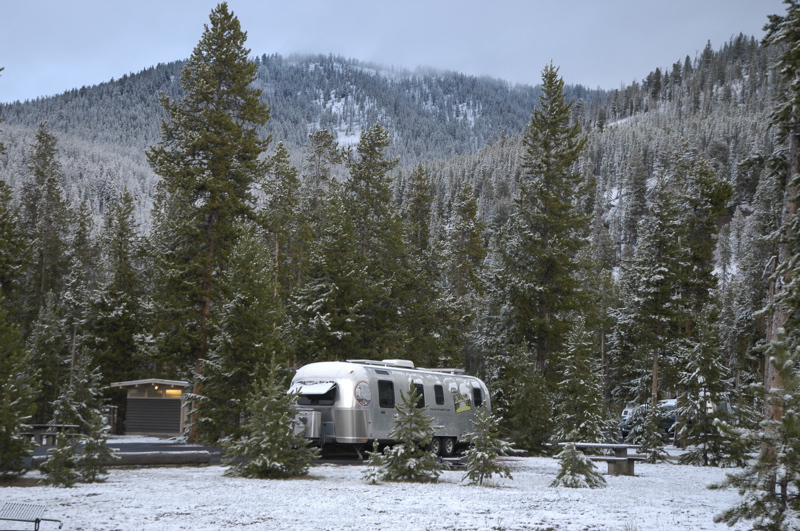
Our entry step was completely coated in ice when I went out, and I found Bert standing at his awning looking at a heap of snow and ice that had coated it and distorted the fabric. He had put his awning out the day before to protect his generator from the rain, but hadn’t anticipated that the rain would become ice.
Like us, Bert and Janie were planning to leave Madison campground today. They were headed off to Grand Teton’s last open campground (Signal Mountain) to find some moose. But first, they had to figure out how to remove inches of snow and ice from their awning and their slide-out. We ended up beating on the ice and sweeping repeatedly, while waiting for the temperature to rise above freezing. Eventually enough was removed for him to roll up the awning and go, but it was far from clean and dry.
I had the same problem with the folding bicycle I’d left cabled to the hitch overnight, but it was easier to de-ice. I hauled it into the Airstream and let it melt on a towel for an hour.
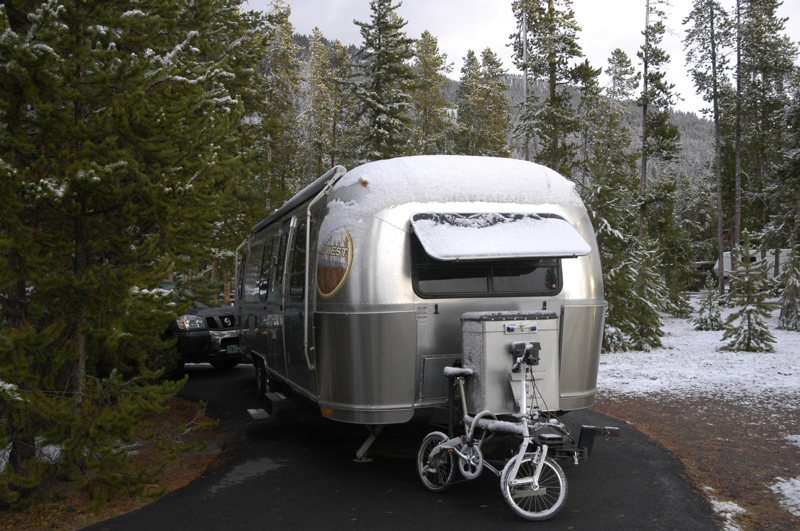
Yellowstone is just as beautiful in the snow as it was last week in the sun. The meadows glow gold when struck by the light, and the broad flat rivers still glisten and burble and sprout fly-fishermen in hip waders. The mountains are draped with cloud and the bison are coated with frost on their dark woolly manes.
It all works so well that I almost began to despair at the excess of photographic opportunities. There simply wasn’t enough time, even in six days and nights, to begin to capture this place. I shot over eight hundred photographs (culled to about 400 hundred at this point, and still going). It wasn’t enough.
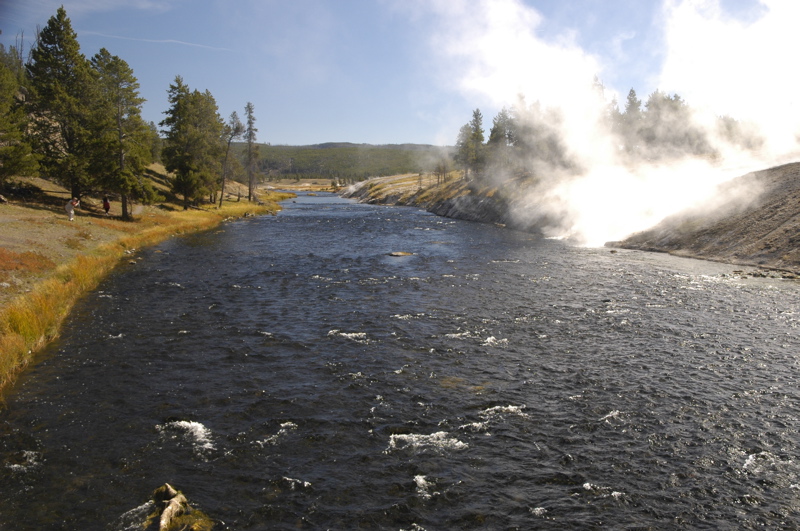
Steaming hot water pours down from Grand Prismatic Geyser into the Firehole River
We came out of the six-night “no-hookup” camping experience in Yellowstone surprisingly well. Despite trees shading our solar panels, freezing temperatures every night, and a few cloudy days, we emerged with this final status:
28 degrees at 8:00 a.m. Snow on panels. -133 amp-hours cumulative (50 amp-hours used overnight)
That’s not bad at all. As I noted when we left Cody, our safe useful battery power is 150 amp-hours (out of 300 total in the bank), and even after six nights we didn’t hit our limit. The key was serious conservation, primarily by keeping the furnace set low at night. We settled on 50 degrees as our overnight setting, which wasn’t bad at all with a lot of blankets on the beds. Bert and Janie set theirs at 40 degrees and sleep in sleeping bags. This morning we met a fellow in a fifth wheel who says his insulation is virtually non-existent and so they just turn off the furnace at night. Compared to them, we are total weenies.
Water-wise we did even better. Our 39-gallon fresh water tank was still about 1/3 full when we left. We took a total of six showers between us (with minor sponge baths from the sink between showers), used the bathroom at night, and did a few dishes when we didn’t feel like going out to the campground sink. It was really great to test our ability to camp on minimal resources, like the old days when we were tenting, and know what our Airstream can do.
Some of you may be reading this and thinking, “How horrible — sponge baths, a cold trailer, no TV,” but really it’s fun. It’s a game to see how long we can stretch a gallon of water, how long we can make a battery last, and how well we can keep ourselves entertained in a place with relatively few of the modern distractions.
After six nights it was time to go find a place to replenish our supplies. We’re now in a commercial campground in the little town of West Yellowstone MT, just a half mile from the park gate. This place has what we need for the next few days: electrical power, stores, cell phone service, Internet, propane. I’m going to sit down before my computer and get some progress on the layouts for the upcoming Winter 2007 magazine, and we’ll also re-stock for a few more days of boondocking in Montana next week.
Bert & Janie got skunked on their plan to head down to Grand Teton. The snow last night caused road closures heading south, and they were forced back north. They also heard from Eric and Sue that the moose were being elusive. So now they’re here, parked right next to us for the next two days, doing the same things we are. Well, except for one thing: Bert had to open his awning up again to melt the last of the ice that got rolled up in it this morning. Now it looks normal again.
Once we’re all caught up, the plan is to head up to some ghost towns in Montana, but I’ll tell you about that later.
August 23, 2007 at 11:19 am · Filed under Mobile technology
According to the blurb on the cover, I get Fortune Small Business magazine because I am an American Express Business Cardmember. Usually I find most of the magazine’s content to be irrelevant to the type of business I run (small, virtual, mobile) but in the Sept 2007 issue I was amused to find a piece entitled, “Business in a Backpack”.
In it, the author, Michelle Labrosse, describes how she is able to run a $9 million company with 30 employees and 40 contractors from her backpack. (You can read the article here.) In the magazine, a photo of the backpack’s contents was provided, which is pictured below since it doesn’t seem to appear in the online version.
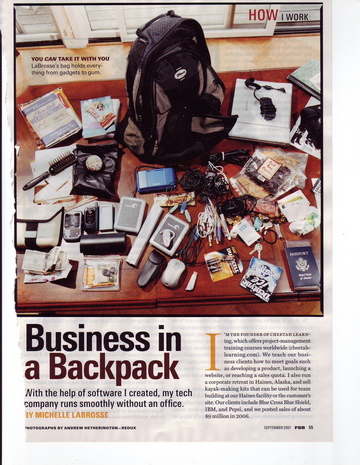
Click for larger
I’ve often written about how I run my business from the road, including my strategies of digitizing all paper, using online software tools, and using mobile technology for voice and Internet. A lot of how I do things is echoed in the FSB article. It was encouraging to see that the solutions I — and many other mobile small businesspeople — have worked out have finally started to get acknowledged by the business media.
The author keeps a lot more tech in her bag than I do. She’s got a Blackberry, a Bluetooth headset, a GPS locator beacon, a noise-canceling headset and a lot more cords. Plus she carries emergency food for long airplane rides. All that stuff makes her bag about 15 pounds heavier than mine. But then, I don’t fly very much these days, and I definitely don’t ride bush planes in Alaska, so the GPS locator and noise-canceling headset aren’t necessary for me.
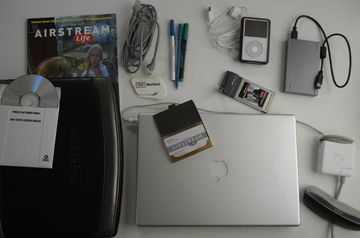
Contents of my mobile office bag. Click for larger
My bag contains many of the same items: laptop, wireless card, iPod, sunglasses, and cell phone. I also carry an external Lacie hard drive, a blank CD-R with mailer, an Ethernet cable, and a portfolio containing notepad, pens, and paperwork that I’m currently dealing with. I also carry a few small bits not pictured above: a thumbdrive (also known as a USB key) for exchanging files, a cable that connects my laptop to a presentation projector, and a flash card reader. (I don’t put things like money and keys in my bag. Those usually ride in my pockets.)
My goal is to keep the bag as light as possible, so I try to avoid excess technology. My laptop does almost everything for me. Since it is a Mac Powerbook it conveniently goes to sleep in about 2 seconds and wakes up equally fast, which means it is readily available to answer my questions at any time. The iPod and cell phone both carry copies of my Contact list, and I find it sufficient to get my email in one place (the laptop) so I don’t feel the need for a separate PDA, organizer, or Blackberry. Consolidating the tech means fewer chargers and cords to deal with.
There are some “outside the bag” pieces of tech that I use occasionally, but don’t usually carry around when I’m working at remote locations. These include the flatbed scanner that I use to convert paper into PDFs, my camera bag, and a backup hard drive. I also have other stuff in the Airstream for specific tasks, like a printer, FedEx envelopes, spare magazines, an Airport Express, etc. But for grab-and-go office work, my backpack works just like Ms. Labrosse’s backpack.
Slowly the business world is catching on to the idea that people can work very efficiently with less, and that offices are not about banks of file cabinets anymore. In the meantime, the low cost and high efficiency of this format is working for a lot of RV’ers and traveling entrepreneurs.
August 6, 2007 at 11:02 pm · Filed under Maintenance, Mobile technology
The hike was too much for Emma yesterday. I’m glad we called it off rather than completing the hike, because she spent the rest of the day lounging and still slept 12 hours last night. She awoke today to find gray drippy skies, cool temperatures, and Mom and Dad firmly parked in the Airstream.
Eleanor is still deep into Harry Potter, feverishly reading Book 4 at this point. As a writer, I feel her speed-reading of the series is an affront to J.K. Rowling. It took a year to write each book and Eleanor is gulping them down like goldfish crackers. If Eleanor continues at this pace, her head will likely explode. She admits to having Harry Potter dreams each night. But she’s under a magic spell of sorts and so she spent the morning reading about Harry and Hermione and Ron again.
Being a gloomy Monday, and since I am recharged with a week’s worth of sunshine and good times, I felt it was appropriate to get right back to work and deal with some ugly accounting issues that I’ve been postponing, related to our new bookstore accounts.
New bookstore accounts, you ask? Yes! The Fall 2007 issue of Airstream Life is going to be available in select Barnes & Noble, Borders, Hastings, and Books-A-Million bookstores as of Aug 22, 2007! That’s huge news for us, drastically broadening the reach of Airstream Life magazine, but it also means I’ve got more work to do each quarter, keeping track of the complex bookstore sales-return accounts.
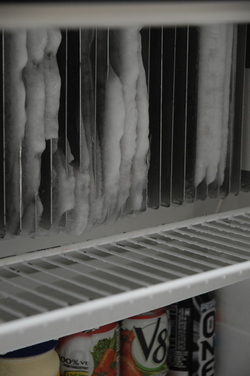
Eleanor finally put down Harry and got into her long-postponed task too, which was defrosting the refrigerator. Being full-timers, our refrigerator is never turned off. So eventually, it needs defrosting. This time we let it go a little too far. The coils were completely encased in ice (above photo shows them half-cleared), which really limits the ability of the refrigerator to cool itself.
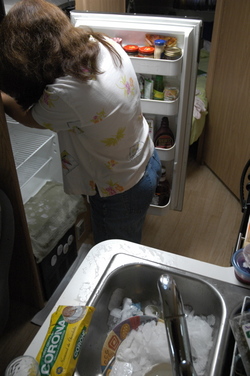
It turned out to be an ideal task for the day. The cool weather meant she could put everything in an ice chest for the hour or so it took to do the job, without worry of food spoiling, and with Emma paused by the cold virus, there wasn’t much else to do anyway.
I had another task related to full-timing, too. A few months ago I moved our company bank account because the bank we were using had completely inadequate online services. As I’ve mentioned, I run an entirely virtual business and am dependent on good online services from as many vendors as possible. Our former bank couldn’t give me online access to our business line of credit, couldn’t manage online transfers between accounts, couldn’t supply monthly statements that showed the names of payees (even when I used their bill pay service!), and in general has been about as hip to the Internet as Lawrence Welk. When I sent a payment to the line of credit at their bank using their bill pay service, it took five days to clear, because — get this — they cut a paper check and sent it to another branch of their own organization.
Today I went into the local branch to close the old accounts. I felt I needed to look the branch manager who opened the accounts for me several years ago right in the eye and tell him honestly but politely why I was switching. He understood my reasoning and sent me to the teller windows to get the job done. And here’s what happened:
1) The teller could not get a payoff amount for the line of credit. She didn’t have access to that information, even though I opened the line of credit at that specific branch.
2) The teller called the bank’s account closure department and THEY couldn’t tell us the payoff. They can only fax the payoff amount “within 24-48 hours”. (What if you don’t have a fax?)
3) They told me that once I got the payoff amount via fax, I’d need to come into the bank to actually make the payoff (or call it in). Can’t do it online, of course.
4) They couldn’t close the line of credit account, because I need to send in a “request” via fax referencing the “request number” I was given over the phone when I, uh, made the request. Got that?
5) They couldn’t close the checking account because it will take five days to clear the payment I’m making, even though that payment is from their bank to their bank.
So in the end, I got virtually nothing done as a result of my twenty minutes at the bank. I’m not mentioning the name of the bank out of respect for my friends who work there, but I’m sharing this story as an example. Those of you who want to work on the road: My recommendation is to have low tolerance for large businesses who still can’t provide decent online tools.
To those of you in the banking industry: Quit spending all your time merging with each other and start competing! My bank has been through half a dozen mergers in the past few years, and each time the changes they institute “to serve you better” haven’t done a bit of good. I don’t care how many branches you have. In the age of the Internet, for me, bank branch offices are about as useless as travel agent offices. Haven’t stepped into a travel agent’s office in over ten years… and considering how little I managed to accomplish as a result of my visit to the local bank branch, I suspect it will be a long time before I bother doing that again either.
Surprisingly, I came out of the bank amused rather than aggravated. I can only attribute this to the fact that we’ve had such a spectacular past week. Or maybe it’s just having extra space in the refrigerator …
August 1, 2007 at 9:48 pm · Filed under Mobile technology
We are often asked the same questions about our life over and over again, which is not a surprise. But it does surprise me that I am asked more often about how we get Netflix on the road than I am asked about how I manage to work. Most people don’t want to talk about work in the same conversation as RV’ing, I guess.
I’m actually rather proud of my portable office. After all, I run the operations of a quarterly magazine, in addition to writing, photographing, and editing it, all from a hundred different locations each year. Ordinary “road warriors” no longer impress me — sure, it sounds glamorous working from a Business Class seat on an airplane or from the comfortable hotel in Tokyo, but try doing it while crouching outside a closed coffee shop at midnight in Las Vegas while skateboard punks roll by. Or on a picnic table in the dark somewhere in Virginia. Or in 103 degree heat in Death Valley. Then you’ll be talking my language.
If you saw the movie “RV” with Robin Williams recently, you might recall the scene where he takes his laptop into the campground bathroom to upload some files. Like most of the rest of the movie, it was a fanciful idea. I remember thinking as I watched it, “Come on, Robin! You’ll never get a signal inside that concrete blockhouse!” My mobile worker instincts kicked in and I was silently urging him to get outside and perhaps find a picnic table to stand on.
You’ve got to be flexible to work on the road 365 days a year. I mean that in the literal sense (try balancing a laptop on one knee while typing with the other and trying not to topple over into the mud), and the figurative sense (dealing with constantly changing environments).
Just as importantly, you need to be extremely efficient. I’ve often talked about my efforts to eliminate paper in order to cut weight and bulk in the trailer. By scrupulously scanning almost everything into Portable Document Format (PDF), I can keep the amount of paper on my “desk” to no more than ten sheets of paper at a time, usually.
So my “desk” is actually a backpack that I picked up at a Florida flea market a year or so ago. It contains a zip-up organizer with room for loose paper, CDs, a pen, and a pad; my laptop, charger, and Verizon aircard in a padded case; and in the outer pockets there are business cards, cables, a mini letter opener, phone charger and a few other odds and ends.
When I think of the desk I left behind two years ago, I am amazed at how things have changed. My old desk was littered with paper, tape, Post-It notes, a stapler, file folders, a multi-line telephone with headset, and fax machine. Beneath it was 50 pounds of paper in two file drawers. In the closet behind me were shelves of office supplies, discs, more files, more cables, and obsolete office equipment of every possible description.
The laptop and the Internet are responsible for most of the change, of course, but a strong desire to be light and fast has been the key. With my blue backpack I can quickly move from trailer to cybercafe to a friend’s house — and even to a concrete bathroom if I need to — in minutes. On a big day, I’ll also tote along the backup hard drive, scanner, and camera, but that’s rare.
During the Lewis and Clark expedition, Captain Lewis brought a considerable quantity of something called portable soup along. It was an emergency concentrate of boiled and defatted meats with egg whites, and it apparently didn’t appeal to the men of the expedition. When it came down to starving or eating the portable soup, they would take a vote and decide to eat one of their valuable horses instead. I mention this only to point out that sometimes people will choose a self-destructive course rather than change their ways. In talking to people on the road, I’ve found that portable offices are sometimes viewed with the same distaste as portable soup.
No question, it’s a tough concept if you’ve been in traditional offices for a long time. It’s easy to go portable for a day or two, but going longer takes a certain obsession. I’ve been working from the road for over two years, so I guess I’m one of the obsessed ones. It has become such second nature to me that I will probably never bother to set up a permanent office again. I like the atmosphere of change that comes with getting shoved off the dining room table at dinnertime, and relocated to the bed where I have to sit cross-legged while I type. The constant change of scene reminds me of the excitement of travel, and it forces me to remain as efficient as I can possibly be. Beyond that, being fully portable precludes the possibility that I might have to dust my office someday.
July 22, 2007 at 8:26 am · Filed under Mobile technology
Our relocation to a new campsite near Vergennes VT has reminded me that sometimes you need to be a bit of a computer handyman, if you are to get reliable Internet service while traveling. Our axiom is that the more desirable and beautiful a location is, the less likely you are to find Internet access. That means you need to get clever about getting online.
Vergennes is one of those spots in Vermont where Verizon has been unable or unwilling to provide decent service. The Governor of Vermont is on a rampage about this issue and has proposed that Vermont become an “e-state” with border-to-border cellular and Internet coverage. Unicell, a local provider, seems to be making an effort to fill in the many gaps, and so I’m hearing from a lot of people here that they’ve switched to Unicell lately.
Certainly, Unicell customers can make a decent call in downtown Vergennes without having it drop in a minute or so. That’s not the case with Verizon, at least by my recent experience. But switching carriers isn’t an option for national travelers, and besides, I have two Verizon accounts (one for voice and the other for Internet).
So here’s where getting clever comes in. My first thought was to scan the local campground for stray wi-fi signals that I might pick up. No dice. My second idea was to go into downtown Vergennes and look for a spot where I could sit and work within range of free wi-fi. The public library doesn’t have it, but eventually I discovered (by asking around) that I could get an open wi-fi signal when sitting in the front of a particular cafe.
Still, that wasn’t my first choice for all-day work. Eventually the cafe would get busy and I’d probably be asked to move on. It’s not a large place.
Then I talked to the campground owner. Turns out his wife has high-speed DSL in the house, and it’s hooked to wi-fi. A quick roam around the area with my laptop open, and it is determined that by sitting on their front porch I can post this blog. OK, we have a temporary solution, but obviously that’s not going to work long term. Also, her local Internet Service Provider blocks all outgoing email except from their email server, so we’ve got a second problem to solve.
Now I break out my tools. The key is the to extend her signal to my trailer, so I can work comfortably in my office. I’ll set up my wi-fi repeater in a conveniently located barn, about mid-way between the house and my trailer. Hopefully that will bridge the gap.
Solving the email problem is easier. Based on our location, it wasn’t hard to guess which telephone company provides her DSL service, and so I can easily figure out (with some web searches) what email server I should set my email program to use. One simple change in configuration, and voila! I am sending and receiving email just fine.
If the wi-fi router hadn’t been “open” (unencrypted), I would have had a larger problem. In this case, the owners are friendly enough that they would have given me the passcode so I could at least get online from the front porch. My repeater is incapable of repeating an encrypted signal, however, so this would not have allowed me to get the signal in my trailer.
If I were really lucky, they might even have let me come in and fiddle with the router settings, once I’d proven I was trustworthy enough to disable the encryption and put it back when I was done. I don’t push on things like this, because often people feel that letting a stranger play with their router is like giving me the keys to their car and a credit card. But once in a while this works. That’s an advanced gambit and I wouldn’t recommend you try it unless you are very familiar with how routers work and willing to pay the price if you screw it up.
In any case, if I can get Internet in the trailer and at least be able to make phone calls outside (which I seem to be able to do most of the time), we will stay here a couple of weeks. If not, we’ll have to move — which would be a shame since the setting is very pleasant and the camping is very affordable …
July 18, 2006 at 7:23 pm · Filed under Maintenance, Mobile technology
If problems come in threes, I’m afraid I’m in for a two-fer. And you’re in for a long blog entry, because I’m going to tell you the whole story right now.
Modern full-timers rely on technology to get things done. In my case, I rely on it more than most, because I’m running a business from my trailer. So when things fail, backup plans are needed. But what do you do when the entire support system starts to collapse?
It started with our Garmin GPS. A couple of weeks ago while in Glacier we noticed that the internal battery was no longer holding a charge. This means the GPS has to do a “cold start” every time we use it, which takes a long time. We’ve come to depend on “Garminita” (as we call the British voice programmed into our unit). Having to wait five minutes or so before she woke up and started telling us where to go, has been a nuisance.
I contacted Garmin support yesterday from Jackson WY via email, and they’ve advised me that they’ll fix Garminita under warranty, but we need to ship her back to the factory and have a UPS-shippable address for the return in 7 to 10 days. I will notify them that we’ll pick Garminita up in Denver. The trick here is knowing where we’re going to be in 7 to 10 days “¦
As I mentioned earlier this week, my Mac’s hard drive failed during our stay in Yellowstone last week. I had a full system backup from 10 days earlier, and since I recognized the symptoms of hard disk failure, I was able to retrieve nearly all of my intervening work before the drive completely died. In just an hour I was able to move to the backup laptop (Eleanor’s) and resume working as if nothing had happened. So that’s OK for now, but we’ll need to find a Mac Service Center, and it seems the closest one along our route is again in Denver.
We weren’t planning to be in Denver for more than a day, but it looks like things could be changing.
Two days later, we picked up a screw in one of the trailer tires. Fortunately, we had a spare, because the screw punctured the tire in a place where patches are not advisable, and we were 60 miles from a tire dealer. OK. We’ll probably replace the spare in Rock Springs WY.
Lately, my Verizon cell phone has been performing poorly. I’ve been missing a lot of calls, and it has been roaming to analog when other phones nearby are making digital calls with no trouble. Right now, it reporting “No Service” but Rich C’s Verizon phone is happily placing digital calls everywhere in the campground. Admittedly this is not a huge surprise, since the phone got, uh, “damp” when Brett and I were jetskiing on Lake Mead last month.
I checked the Verizon website at the public library today and found that there was an authorized outlet in the Radio Shack up in Driggs. Perfect ““ only a few miles up the road. I got my opportunity to go check it out around 2 pm. There was a small fire across the street near the Market & Café, and the whole downtown was blacked out, which eliminated all the free wi-fi in town. So Rich C and I headed up to Driggs.
No luck. Verizon apparently has an east-west division, and authorized re-sellers from the west can’t sell me an upgrade phone since we’re from the east. I was advised to try the Verizon store in Idaho Falls, an hour away.
OK, but before I drive an hour, I’m going to call and make sure they can help me. Hmmm”¦ how to call Verizon? I would dial 611 from my phone, but it’s saying it doesn’t feel like placing a call. So I borrow Rich C’s Verizon phone and try 611.
No dice. We’re on an extended network and 611 doesn’t work. So I borrow a Yellow Pages from the campground and find the number for the Idaho Falls store. After a long wait, the tech support rep comes on and tells me that comparing two phones side-by-side isn’t really a reliable way to know if my phone isn’t working well. “One phone may be tri-mode, while another is pure digital, and you have different manufacturers, ages, etc,” she explains.
Well, that’s all nice, but I want the phone that works! I explain this concept to the friendly tech, who then tells me that my phone is out of warranty, and if I can just hang on to my malfunctioning phone for two more months, I’ll get a cheap “upgrade” to a phone that works, whereas if I insist on a replacement now, it will cost me the full retail price.
Two months with my phone only working when I’m standing directly under a cell tower? No thanks. Rich C, who used to work in the cell phone industry (as did I), calls this “standard service.”
So we have a dead tire, a dead computer, a faulty GPS, and a deeply traumatized phone. But we’re standing tall nonetheless. Yes, my technology is collapsing around me, and I need my technology, but we’re just going to be flexible.
What do you do in this situation? There are two basic options: (1) flee to a major city and get everything fixed; (2) extend your stay and try to work things out via Internet and UPS/FedEx. We like it here, so we’ve booked another two nights. I’ll take a few hours to make the arrangements for repairing everything.
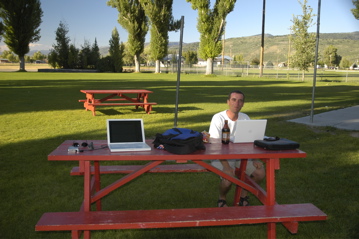
Duelling Macs on the picnic table in Victor, Idaho
UPDATE: Rich C and I went back to the park beside the Library on this fine evening and found power restored. We’re both blogging and doing other work from a picnic table. Eleanor and Emma are off at the shoppe across the street getting ice cream sodas. It’s another gorgeous evening in Victor ID.
« Previous entries










